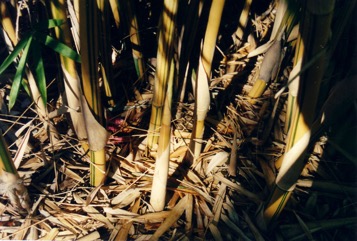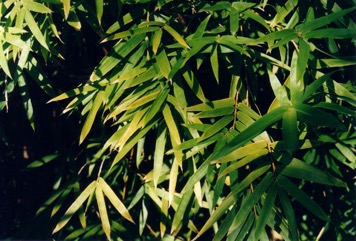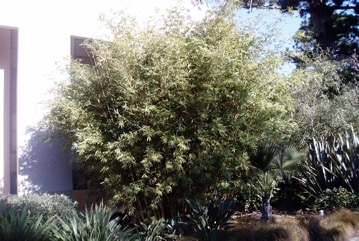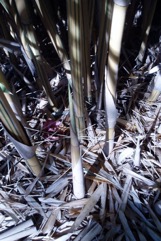Hedge Bamboo, Chinese dwarf bamboo

A tropical and subtropical plant. In SE Asia it grows up to 1,500 m altitude. It tolerates temperatures as low as -8°C. It grows well on sandy soils. It needs a reasonable rainfall. It needs rich moist soils. It needs a sunny position. It is resistant to frost. It suits hardiness zones 9-12. Melbourne Botanical Gardens. Geelong Botanical Gardens. In XTBG Yunnan. In Sichuan.
Also known as:
Aor selat, Aur cino, Awi krisik, Bambi pagar, Bambu cina, Buloh china, Buloh pagar, Buluh pagar, Cay hop, Horai-chiku, Kawayan tsina, Nsungwi, Pa-lau-pinan-wa, Phai-li-ang, Pring chendani, Pring tjendani, Russei tae
Synonyms
- Arundo multiplex Lour.
- Bambusa glaucescens (Willd.) Sieb. ex Munro
- Bambusa argentea
- Bambusa nana Roxb.
- and many others
Edible Portion
- Shoots
Where does Hedge Bamboo grow?
Found in: Africa, Asia, Australia, Bangladesh, Cambodia, China, East Africa, Fiji, Hawaii, Himalayas, India, Indochina, Indonesia, Japan, Laos, Malawi, Malaysia, Marquesas, Myanmar, Nepal, Northeastern India, Pacific, Philippines, Pakistan, SE Asia, Sri Lanka, Taiwan, Thailand, Vietnam, United States
Notes: There are about 120 Bambusa species. They are tropical and subtropical in Asia.
Status: It is cultivated.
Growing Hedge Bamboo, Chinese dwarf bamboo
Cultivation: It is usually grown from rhizome cuttings or shoots. It can be used as a hedge or living fence.
Edible Uses: The young shoots are edible. They are bitter so need to be harvested before they emerge from the soil. They are lightly cooked. They are also used in soup.
Nutrition Info
per 100g edible portion| Edible Part | Energy (kcal) | Protein (g) | Iron (mg) | Vitamin A (ug) | Vitamin c (mg) | Zinc (mg) | % Water |
|---|---|---|---|---|---|---|---|
| Shoots | - | - | - | - | - | - |
Hedge Bamboo, Chinese dwarf bamboo Photos




References
Arora, R. K., 2014, Diversity in Underutilized Plant Species - An Asia-Pacific Perspective. Bioversity International. p 36
Bircher, A. G. & Bircher, W. H., 2000, Encyclopedia of Fruit Trees and Edible Flowering Plants in Egypt and the Subtropics. AUC Press. p 53 (Also as Bambusa nana)
Bodkin, F., 1991, Encyclopedia Botanica. Cornstalk publishing, p 127 (As Bambusa glaucescens)
Brickell, C. (Ed.), 1999, The Royal Horticultural Society A-Z Encyclopedia of Garden Plants. Convent Garden Books. p 159
Burkill, I.H., 1966, A Dictionary of the Economic Products of the Malay Peninsula. Ministry of Agriculture and Cooperatives, Kuala Lumpur, Malaysia. Vol 1 (A-H) p 301 (As Bambusa glaucescens)
Creasey, R., 2000, The Edible Asian Garden. Periplus p 22 (As Bambusa glaucescens)
Crouzet, I., Starosta, P., 1998, Bamboos. Evergreen. p 17
Cundall, P., (ed.), 2004, Gardening Australia: flora: the gardener's bible. ABC Books. p 217
Dransfield, S. & Widjaja, EA., 1995, Plant Resources of South East Asia. PROSEA No. 7 Bamboos. Leiden. p 65
Etherington, K., & Imwold, D., (Eds), 2001, Botanica's Trees & Shrubs. The illustrated A-Z of over 8500 trees and shrubs. Random House, Australia. p 114
Facciola, S., 1998, Cornucopia 2: a Source Book of Edible Plants. Kampong Publications, p 46
Flora of Pakistan. www.eFloras.org (As Bambusa glaucescens)
Hariyadi, B., 2008, The Entwined Tree: Traditional Natural Resource Management of Serampas, Jambi, Indonesia. Ph. D thesis. Univ. or Hawaii. p 401
Heyne, 1927 ed, K., Nutt. Plant. Ned. Ind. p 296 (As Bambusa glaucescens)
Hibbert, M., 2002, The Aussie Plant Finder 2002, Florilegium. p 37 (Also as Bambusa glaucescens)
Kew Bull. 11:207. 1956 (As Bambusa glaucescens)
Kumari, P, 2019, Bambusoideae in India: An Updated Enumeration. Plantae Scientia : Volume 01, Issue 06, March 2019
Levy-Yamamori, R., & Taaffe, G., 2004, Garden Plants of Japan. Timber Press. p 364
Lord, E.E., & Willis, J.H., 1999, Shrubs and Trees for Australian gardens. Lothian. p 93
Martin, F.W. & Ruberte, R.M., 1979, Edible Leaves of the Tropics. Antillian College Press, Mayaguez, Puerto Rico. p 194
Ochse, J.J. et al, 1931, Vegetables of the Dutch East Indies. Asher reprint. p 301
Phon, P., 2000, Plants used in Cambodia. © Pauline Dy Phon, Phnom Penh, Cambodia. p 87
Setiya, A. V., et al, 2016, Exploration and documentation of some wild edible plants used by the aboriginals from Gadchiroli District (M.S.) India. International Advanced Research Journal in Science, Engineering and Technology. 3(7) (As Bambusa glaucescens)
Singh, P., et al, 2019 Plants of Indian Himalayan region. Part 1 Botanical Surbey of India. p
Smith, A.C., 1979, Flora Vitiensis Nova, Lawaii, Kuai, Hawaii, Volume 1 p 296
Staples, G.W. and Herbst, D.R., 2005, A tropical Garden Flora. Bishop Museum Press, Honolulu, Hawaii. p 743
Sukarya, D. G., (Ed.) 2013, 3,500 Plant Species of the Botanic Gardens of Indonesia. LIPI p 837 (Also as Bambusa glaucescens)
Syst. veg. 7(2):1350. 1830
Tanaka,
Terra, G.J.A., 1973, Tropical Vegetables. Communication 54e Royal Tropical Institute, Amsterdam, p 27
Valder, P., 1999, The Garden Plants of China. Florilegium. p 95
Williamson, J., 2005, Useful Plants of Malawi. 3rd. Edition. Mdadzi Book Trust. p 34
World Checklist of Useful Plant Species 2020. Royal Botanic Gardens, Kew